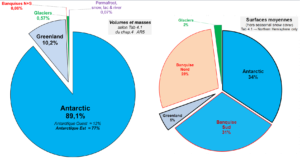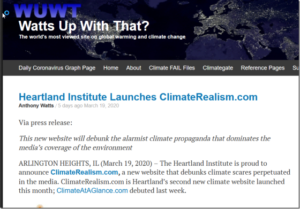by J.C. Maurin, 27 mars 2020 in ScienceClimatEnergie
Partie 2/3 : Lecture critique du chapitre cryosphère de l’AR5
par J.C. Maurin, Professeur agrégé de physique
Cette deuxième partie de l’article examine la composition du chapitre 4 du 5ème rapport du GIEC (AR5) [1].
Dans ce chapitre, qui concerne les différentes composantes de la cryosphère, les banquises [2] et glaciers [3] sont particulièrement mises en avant par les rédacteurs du GIEC.
A propos de ces 2 composantes mineures (0,65 % du volume de la cryosphère), l’article développe certains éléments d’appréciation que les rédacteurs de l’AR5 n’ont pas mis en exergue.
…

Continuer la lecture de Les glaces terrestres, la cryosphère (2/3) →
by P. Homewood, March 24, 2020 in NotaLotofPeopleKnowThat
WUWT has news of a new website launched by the Heartland Institute, to augment the excellent factchecking site, Climate At A Glance:

Nearly every day, the establishment media promotes new climate propaganda themes designed to scare people into believing a climate crisis is at hand. When the Climate Scare goes unrebutted, people are likely to believe by default that the propaganda is true. Yet most of the media’s climate propaganda is misleading or outright false. ClimateRealism.com will address and debunk the media’s most prominent climate-related tall tales.
…
by D. Middleton, March 24, 2020 in WUWT
One of the things I love about writing for Watts Up With That, is the fact that reader comments often inspire me to research and write subsequent posts. In my recent post about the origins of the Moon, one commentator suggested that the rate of lunar recession (tidal acceleration) indicated that the Earth was much younger than 4.5 billion years old and/or somehow disproved the geological Principle of Uniformitarianism. I didn’t give much thought to my reply. I simply calculated the distance from the Earth to the Moon 1 billion and 4.5 billion years ago. The Moon is currently receding (moving away) from the Earth at a rate of about 3.8 cm/yr. This has been directly measured with lasers.
At 3.8 cm/yr, the Moon would have been 215,288 miles away from Earth a billion years ago. It is currently an average of 238,900 miles away. At 3.8 cm/yr, it still would have been 132,646 miles away 4.5 BY.
If the Moon did did originate from a collision with Earth, it would have been a lot closer to Earth 4.5 BY than 100,000 miles.
…
…
by P. Homewood, March 24, 2020 in NotaLotofPeopleKnowThat
Scientists have found a new point of major vulnerability in the Antarctic ice sheet, in a region that already appears to be changing as the climate warms and has the potential to raise sea levels by nearly five feet over the long term.
Denman glacier, in East Antarctica, is a 12-mile-wide stream of ice that flows over the deepest undersea canyon in the entire ice sheet before spilling out into the ocean. That subsea trough is more than 2 miles deep, or double the average depth of the Grand Canyon. While there are far deeper trenches in the open ocean, such as the Marianas Trench, in this case the extreme undersea topography lies right on the outer fringe of the Antarctic continent — making it the “deepest continental point on Earth.”
…
…
In reality the scientists who wrote this study do not have a clue whether the retreat of the Denman is anything new or not, or whether the deep ocean temperatures are any warmer than before 1979. Or whether what they are observing is just a natural process.
We can then go on to explore sea level implications.
They claim that since 1979, 250 billion tonnes of ice has been lost, equivalent to 0.5mm of sea level rise. In other words, 1.3mm/C, hardly cataclysmic.
They then go on to talk about a potential loss of 540 trillion tonnes, raising sea levels by 5 feet. Yet at current rates, it would take 86400 years for this to occur!
As always with these sort of studies, the authors refuse to say how long all this will take to happen.
…
La géologie, une science plus que passionnante … et diverse


